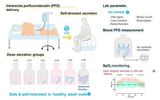Spot Two Comets at Once as Lemmon and SWAN Soar Across Our Skies This Week
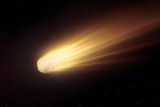

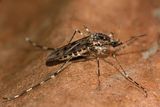
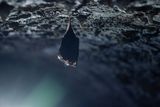

Low-energy electrons escape from some materials via distinct “doorway” states, according to a study done by physicists at Austria’s Vienna Institute of Technology. The team studied graphene-based materials and found that the nature of the doorway states depended on the number of graphene layers in the sample.
Low-energy electron (LEE) emission from solids is used across a range of materials analysis and processing applications including scanning electron microscopy and electron-beam induced deposition. However, the precise physics of the emission process is not well understood.
Electrons are ejected from a material when a beam of electrons is fired at its surface. Some of these incident electrons will impart energy to electrons residing in the material, causing some resident electrons to be emitted from the surface. In the simplest model, the minimum energy needed for this LEE emission is the electron binding energy of the material.
In this new study, however, researchers have shown that exceeding the binding energy is not enough for LEE emission from graphene-based materials. Not only does the electron need this minimum energy, it must also be in a specific doorway state or it is unlikely to escape. The team compare this phenomenon to the predicament of a frog in a cardboard box with a window. Not only must the frog hop a certain height to escape the box, it must also begin its hop from a position that will result in it travelling through the hole (see figure).
For most materials, the energy spectrum of LEE electrons is featureless. However, it was known that graphite’s spectrum has an “X state” at about 3.3 eV, where emission is enhanced. This state could be related to doorway states.
To search for doorway states, the Vienna team studied LEE emission from graphite as well as from single-layer and bi-layer graphene. Graphene is a sheet of carbon just one atom thick. Sheets can stick together via the relatively weak Van der Waals force to create multilayer graphene – and ultimately graphite, which comprises a large number of layers.
Because electrons are mostly confined within the graphene layers, the electronic states of single-layer, bi-layer and multi-layer graphene are broadly similar. As a result, it was expected that these materials would have similar LEE emission spectra . However, the Vienna team found a surprising difference.
The team made their discovery by firing a beam of relatively low energy electrons (173 eV) incident at 60° to the surface of single-layer and bi-layer graphene as well as graphite. The scattered electrons are then detected at the same angle of reflection. Meanwhile, a second detector is pointed normal to the surface to capture any emitted electrons. In quantum mechanics electrons are indistinguishable, so the modifiers scattered and emitted are illustrative, rather than precise.
The team looked for coincident signals in both detectors and plotted their results as a function of energy in 2D “heat maps”. These plots revealed that bi-layer graphene and graphite each had doorway states – but at different energies. However, single-layer graphene did not appear to have any doorway states. By combining experiments with calculations, the team showed that doorway states emerge above a certain number of layers. As a result the researchers showed that graphite’s X state can be attributed in part to a doorway state that appears at about five layers of graphene.
“For the first time, we’ve shown that the shape of the electron spectrum depends not only on the material itself, but crucially on whether and where such resonant doorway states exist,” explains Anna Niggas at the Vienna Institute of Technology.
As well as providing important insights in how the electronic properties of graphene morph into the properties of graphite, the team says that their research could also shed light on the properties of other layered materials.
The research is described in Physical Review Letters.
The post Doorway states spotted in graphene-based materials appeared first on Physics World.


Traditional mining expertise plus space startup innovation will equal the winning formula for lunar resource extraction.
The post The lunar mining gold rush is coming – and success requires bridging two worlds appeared first on SpaceNews.

Vantor’s space-to-space intelligence business is also known as non-Earth imagery
The post Vantor satellites track space objects in ‘blind spots’ inaccessible to military ground sensors appeared first on SpaceNews.
NASA’s Jet Propulsion Laboratory (JPL) is to lay off some 550 employees as part of a restructuring that began in July. The action affects about 11% of JPL’s employees and represents the lab’s third downsizing in the past 20 months. When the layoffs are complete by the end of the year, the lab will have roughly 4500 employees, down from about 6500 at the start of 2024. A further 4000 employees have already left NASA during the past six months via sacking, retirement or voluntary buyouts.
Managed by the California Institute of Technology in Pasadena, JPL oversees scientific missions such as the Psyche asteroid probe, the Europa Clipper and the Perseverance rover on Mars. The lab also operates the Deep Space Network that keeps Earth in communication with unmanned space missions. JPL bosses already laid off about 530 staff – and 140 contractors – in February last year followed by another 325 people in November 2024.
JPL director Dave Gallagher insists, however, that the new layoffs are not related to the current US government shutdown that began on 1 October. “[They are] essential to securing JPL’s future by creating a leaner infrastructure, focusing on our core technical capabilities, maintaining fiscal discipline, and positioning us to compete in the evolving space ecosystem,” he says in a message to employees.
Judy Chu, Democratic Congresswoman for the constituency that includes JPL, is less optimistic. “Every layoff devastates the highly skilled and uniquely talented workforce that has made these accomplishments possible,” she says. “Together with last year’s layoffs, this will result in an untold loss of scientific knowledge and expertise that threatens the very future of American leadership in space exploration and scientific discovery.”
John Logsdon, professor emeritus at George Washington University and founder of the university’s Space Policy Institute, says that the cuts are a direct result of the Trump administration’s approach to science and technology. “The administration gives low priority to robotic science and exploration, and has made draconic cuts to the science budget; that budget supports JPL’s work,” he told Physics World. “With these cuts, there is not enough money to support a JPL workforce sized for more ambitious activities. Ergo, staff cuts.”
The post NASA’s Jet Propulsion Lab lays off a further 10% of staff appeared first on Physics World.

SpaceX Chief Executive Elon Musk hurled insults at NASA’s acting administrator a day after complaints that the company was behind schedule on its Artemis lunar lander.
The post Musk criticizes Duffy amid NASA leadership debate appeared first on SpaceNews.
I hugely enjoyed physics when I was a youngster. I had the opportunity both at home and school to create my own projects, which saw me make electronic circuits, crazy flying models like delta-wings and autogiros, and even a gas chromatograph with a home-made chart recorder. Eventually, this experience made me good enough to repair TV sets, and work in an R&D lab in the holidays devising new electronic flow controls.
That enjoyment continued beyond school. I ended up doing a physics degree at the University of Oxford before working on the discovery of the gluon at the DESY lab in Hamburg for my PhD. Since then I have used physics in industry – first with British Oxygen/Linde and later with Air Products & Chemicals – to solve all sorts of different problems, build innovative devices and file patents.
While some students have a similarly positive school experience and subsequent career path, not enough do. Quite simply, physics at school is the key to so many important, useful developments, both within and beyond physics. But we have a physics education problem, or to put it another way – a “future of physics” problem.
There are just not enough school students enjoying and learning physics. On top of that there are not enough teachers enjoying physics and not enough students doing practical physics. The education problem is bad for physics and for many other subjects that draw on physics. Alas, it’s not a new problem but one that has been developing for years.
Many good points about the future of physics learning were made by the Institute of Physics in its 2024 report Fundamentals of 11 to 19 Physics. The report called for more physics lessons to have a practical element and encouraged more 16-year-old students in England, Wales and Northern Ireland to take AS-level physics at 17 so that they carry their GCSE learning at least one step further.
Doing so would furnish students who are aiming to study another science or a technical subject with the necessary skills and give them the option to take physics A-level. Another recommendation is to link physics more closely to T-levels – two-year vocational courses in England for 16–19 year olds that are equivalent to A-levels – so that students following that path get a background in key aspects of physics, for example in engineering, construction, design and health.
But do all these suggestions solve the problem? I don’t think they are enough and we need to go further. The key change to fix the problem, I believe, is to have student groups invent, build and test their own projects. Ideally this should happen before GCSE level so that students have the enthusiasm and background knowledge to carry them happily forward into A-level physics. They will benefit from “pull learning” – pulling in knowledge and active learning that they will remember for life. And they will acquire wider life skills too.
During my time in industry, I did outreach work with schools every few weeks and gave talks with demonstrations at the Royal Institution and the Franklin Institute. For many years I also ran a Saturday Science club in Guildford, Surrey, for pupils aged 8–15.
Based on this, I wrote four Saturday Science books about the many playful and original demonstrations and projects that came out of it. Then at the University of Surrey, as a visiting professor, I had small teams of final-year students who devised extraordinary engineering – designing superguns for space launches, 3D printers for full-size buildings and volcanic power plants inter alia. A bonus was that other staff working with the students got more adventurous too.
But that was working with students already committed to a scientific path. So lately I’ve been working with teachers to get students to devise and build their own innovative projects. We’ve had 14–15-year-old state-school students in groups of three or four, brainstorming projects, sketching possible designs, and gathering background information. We help them and get A-level students to help too (who gain teaching experience in the process). Students not only learn physics better but also pick up important life skills like brainstorming, team-working, practical work, analysis and presentations.
We’ve seen lots of ingenuity and some great projects such as an ultrasonic scanner to sense wetness of cloth; a system to teach guitar by lighting up LEDs along the guitar neck; and measuring breathing using light passing through a band of Lycra around the patient below the ribs. We’ve seen the value of failure, both mistakes and genuine technical problems.
Best of all, we’ve also noticed what might be dubbed the “combination bonus” – students having to think about how they combine their knowledge of one area of physics with another. A project involving a sensor, for example, will often involve electronics as well the physics of the sensor and so student knowledge of both areas is enhanced.
Some teachers may question how you mark such projects. The answer is don’t mark them! Project work and especially group work is difficult to mark fairly and accurately, and the enthusiasm and increased learning by students working on innovative projects will feed through into standard school exam results.
Not trying to grade such projects will mean more students go on to study physics further, potentially to do a physics-related extended project qualification – equivalent to half an A-level where students research a topic to university level – and do it well. Long term, more students will take physics with them into the world of work, from physics to engineering or medicine, from research to design or teaching.
Such projects are often fun for students and teachers. Teachers are often intrigued and amazed by students’ ideas and ingenuity. So, let’s choose to do student-invented project work at school and let’s finally solve the future of physics problem.
The post How to solve the ‘future of physics’ problem appeared first on Physics World.
The control of large, strongly coupled, multi-component quantum systems with complex dynamics is a challenging task.
It is, however, an essential prerequisite for the design of quantum computing platforms and for the benchmarking of quantum simulators.
A key concept here is that of quantum ergodicity. This is because quantum ergodic dynamics can be harnessed to generate highly entangled quantum states.
In classical statistical mechanics, an ergodic system evolving over time will explore all possible microstates states uniformly. Mathematically, this means that a sufficiently large collection of random samples from an ergodic process can represent the average statistical properties of the entire process.
Quantum ergodicity is simply the extension of this concept to the quantum realm.
Closely related to this is the idea of chaos. A chaotic system is one in which is very sensitive to its initial conditions. Small changes can be amplified over time, causing large changes in the future.
The ideas of chaos and ergodicity are intrinsically linked as chaotic dynamics often enable ergodicity.
Until now, it has been very challenging to predict which experimentally preparable initial states will trigger quantum chaos and ergodic dynamics over a reasonable time scale.
In a new paper published in Reports on Progress in Physics, a team of researchers have proposed an ingenious solution to this problem using the Bose–Hubbard Hamiltonian.
They took as an example ultracold atoms in an optical lattice (a typical choice for experiments in this field) to benchmark their method.
The results show that there are certain tangible threshold values which must be crossed in order to ensure the onset of quantum chaos.
These results will be invaluable for experimentalists working across a wide range of quantum sciences.
Pausch et al. 2025 Rep. Prog. Phys. 88 057602
The post A recipe for quantum chaos appeared first on Physics World.
Precision measurements of theoretical parameters are a core element of the scientific program of experiments at the Large Hadron Collider (LHC) as well as other particle colliders.
These are often performed using statistical techniques such as the method of maximum likelihood. However, given the size of datasets generated, reduction techniques, such as grouping data into bins, are often necessary.
These can lead to a loss of sensitivity, particularly in non-linear cases like off-shell Higgs boson production and effective field theory measurements. The non-linearity in these cases comes from quantum interference and traditional methods are unable to optimally distinguish the signal from background.
In this paper, the ATLAS collaboration pioneered the use of a neural network based technique called neural simulation-based inference (NSBI) to combat these issues.
A neural network is a machine learning model originally inspired by how the human brain works. It’s made up of layers of interconnected units called neurons, which process information and learn patterns from data. Each neuron receives input, performs a simple calculation, and passes the result to other neurons.
NSBI uses these neural networks to analyse each particle collision event individually, preserving more information and improving accuracy.
The framework developed here can handle many sources of uncertainty and includes tools to measure how confident scientists can be in their results.
The researchers benchmarked their method by using it to calculate the Higgs boson signal strength and compared it to previous methods with impressive results (see here for more details about this).
The greatly improved sensitivity gained from using this method will be invaluable in the search for physics beyond the Standard Model in future experiments at ATLAS and beyond.
The ATLAS Collaboration, 2025 Rep. Prog. Phys. 88 067801
The post Neural simulation-based inference techniques at the LHC appeared first on Physics World.
As a teenager in her native Rio Grande do Sul, a state in Southern Brazil, Thaisa Storchi Bergmann enjoyed experimenting in an improvised laboratory her parents built in their attic. They didn’t come from a science background – her father was an accountant, her mother a primary school teacher – but they encouraged her to do what she enjoyed. With a friend from school, Storchi Bergmann spent hours looking at insects with a microscope and running experiments from a chemistry toy kit. “We christened the lab Thasi-Cruz after a combination of our names,” she chuckles.
At the time, Storchi Bergmann could not have imagined that one day this path would lead to cosmic discoveries and international recognition at the frontiers of astrophysics. “I always had the curiosity inside me,” she recalls. “It was something I carried since adolescence.”
That curiosity almost got lost to another discipline. By the time Storchi Bergmann was about to enter university, she was swayed by a cousin living with her family who was passionate about architecture. By 1974 she began studying architecture at the Federal University of Rio Grande do Sul (UFRGS). “But I didn’t really like technical drawing. My favourite part of the course were physics classes,” she says. Within a semester, she switched to physics.
There she met Edemundo da Rocha Vieira, the first astrophysicist UFRGS ever hired – who later went on to structure the university’s astronomy department. He nurtured Storchi Bergmann’s growing fascination with the universe and introduced her to research.
In 1977, newly married after graduation, Storchi Bergmann followed her husband to Rio de Janeiro, where she did a master’s degree and worked with William Kunkel, an American astronomer who was in Rio to help establish Brazil’s National Astrophysics Laboratory. She began working on data from a photometric system to measure star radiation. “But Kunkel said galaxies were a lot more interesting to study, and that stuck in my head,” she says.
Three years after moving to Rio, she returned to Porto Alegre, in Rio Grande do Sul, to start her doctoral research and teach at UFRGS. Vital to her career was her decision to join the group of Miriani Pastoriza, one of the pioneers of extragalactic astrophysics in Latin America. “She came from Argentina, where [in the late 1970s and early 1980s] scientists were being strongly persecuted [by the country’s military dictatorship] at the time,” she recalls. Pastoriza studied galaxies with “peculiar nuclei” – objects later known to harbour supermassive black holes. Under Pastoriza’s guidance, she moved from stars to galaxies, laying the foundation for her career.
Between 1986 and 1987, Storchi Bergmann often travelled to Chile to make observations and gather data for her PhD, using some of the largest telescopes available at the time. Then came a transformative period – a postdoc fellowship in Maryland, US, just as the Hubble Space Telescope was launched in 1990. “Each Thursday, I would drive to Baltimore for informal bag-lunch talks at the Space Telescope Science Institute, absorbing new results on active galactic nuclei (AGN) and supermassive black holes,” Storchi Bergmann recalls.
In 1991, during an observing campaign, she and a collaborator saw something extraordinary in the galaxy NGC 1097: gas moving at immense speeds, captured by the galaxy’s central black hole. The work, published in 1993, became one of the earliest documented cases of what are now called “tidal disruption events”, in which a star or cloud gets too close to a black hole and is torn apart.
Her research also contributed to one of the defining insights of the Hubble era: that every massive galaxy hosts a central black hole. “At first, we didn’t know if they were rare,” she explains. “But gradually it became clear: these objects are fundamental to galaxy evolution.”
Another collaboration brought her into contact with Daniela Calzetti, whose work on the effects of interstellar dust led to the formulation of the widely used “Calzetti law”. These and other contributions placed Storchi Bergmann among the most cited scientists worldwide, recognition of which came in 2015 when she received the L’Oréal-UNESCO Award for Women in Science.
Her scientific achievements, however, unfolded against personal and structural obstacles. As a young mother, she often brought her baby to observatories and conferences so she could breastfeed. This kind of juggling is no stranger to many women in science.
“It was never easy,” Storchi Bergmann reflects. “I was always running, trying to do 20 things at once.” The lack of childcare infrastructure in universities compounded the challenge. She recalls colleagues who succeeded by giving up on family life altogether. “That is not sustainable,” she insists. “Science needs all perspectives – male, female and everything in-between. Otherwise, we lose richness in our vision of the universe.”
When she attended conferences early in her career, she was often the only woman in the room. Today, she says, the situation has greatly improved, even if true equality remains distant.
Now a tenured professor at UFRGS and a member of the Brazilian Academy of Sciences, Storchi Bergmann continues to push at the cosmic frontier. Her current focus is the Legacy Survey of Space and Time (LSST), about to begin at the Vera Rubin Observatory in Chile.
Her group is part of the AGN science collaboration, developing methods to analyse the characteristic flickering of accreting black holes. With students, she is experimenting with automated pipelines and artificial intelligence to make sense of and manage the massive amounts of data.
Yet this frontier science is not guaranteed. Storchi Bergmann is frustrated by the recent collapse in research scholarships. Historically, her postgraduate programme enjoyed a strong balance of grants from both of Brazil’s federal research funding agencies, CNPq (from the Ministry of Science) and CAPES (from the Ministry of Education). But cuts at CNPq, she says, have left students without support, and CAPES has not filled the gap.
“The result is heartbreaking,” she says. “I have brilliant students ready to start, including one from Piauí (a state in north-eastern Brazil), but without a grant, they simply cannot continue. Others are forced to work elsewhere to support themselves, leaving no time for research.”
She is especially critical of the policy of redistributing scarce funds away from top-rated programmes to newer ones without expanding the overall budget. “You cannot build excellence by dismantling what already exists,” she argues.
For her, the consequences go beyond personal frustration. They risk undermining decades of investment that placed Brazil on the international astrophysics map. Despite these challenges, Storchi Bergmann remains driven and continues to mentor master’s and PhD students, determined to prepare them for the LSST era.
At the heart of her research is a question as grand as any in cosmology: which came first – the galaxy or its central black hole? The answer, she believes, will reshape our understanding of how the universe came to be. And it will carry with it the fingerprint of her work: the persistence of a Brazilian scientist who followed her curiosity from a home-made lab to the centres of galaxies, overcoming obstacles along the way.
The post ‘Science needs all perspectives – male, female and everything in-between’: Brazilian astronomer Thaisa Storchi Bergmann appeared first on Physics World.


When diamond defects emit light, how much of that light can be captured and used for quantum technology applications? According to researchers at the Hebrew University of Jerusalem, Israel and Humboldt Universität of Berlin, Germany, the answer is “nearly all of it”. Their technique, which relies on positioning a nanoscale diamond at an optimal location within a chip-integrated nanoantenna, could lead to improvements in quantum communication and quantum sensing.
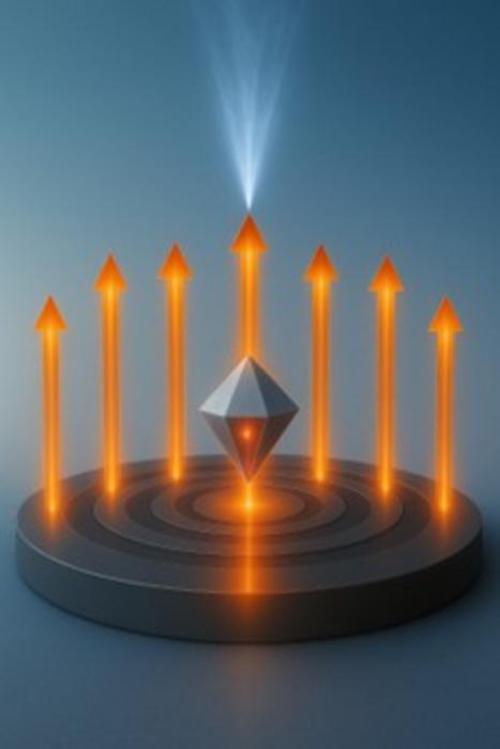
Nitrogen-vacancy (NV) centres are point defects that occur when one carbon atom in diamond’s lattice structure is replaced by a nitrogen atom next to an empty lattice site (a vacancy). Together, this nitrogen atom and its adjacent vacancy behave like a negatively charged entity with an intrinsic quantum spin.
When excited with laser light, an electron in an NV centre can be promoted into an excited state. As the electron decays back to the ground state, it emits light. The exact absorption-and-emission process is complicated by the fact that both the ground state and the excited state of the NV centre have three sublevels (spin triplet states). However, by exciting an individual NV centre repeatedly and collecting the photons it emits, it is possible to determine the spin state of the centre.
The problem, explains Boaz Lubotzky, who co-led this research effort together with his colleague Ronen Rapaport, is that NV centres radiate over a wide range of angles. Hence, without an efficient collection interface, much of the light they emit is lost.
Lubotzky and colleagues say they have now solved this problem thanks to a hybrid nanostructure made from a PMMA dielectric layer above a silver grating. This grating is arranged in a precise bullseye pattern that accurately guides light in a well-defined direction thanks to constructive interference. Using a nanometre-accurate positioning technique, the researchers placed the nanodiamond containing the NV centres exactly at the optimal location for light collection: right at the centre of the bullseye.
For standard optics with a numerical aperture (NA) of about 0.5, the team found that the system captures around 80% of the light emitted from the NV centres. When NA >0.7, this value exceeds 90%, while for NA > 0.8, Lubotzky says it approaches unity.
“The device provides a chip-based, room-temperature interface that makes NV emission far more directional, so a larger fraction of photons can be captured by standard lenses or coupled into fibres and photonic chips,” he tells Physics World. “Collecting more photons translates into faster measurements, higher sensitivity and lower power, thereby turning NV centres into compact precision sensors and also into brighter, easier-to-use single-photon sources for secure quantum communication.”
The researchers say their next priority is to transition their prototype into a plug-and-play, room-temperature module – one that is fully packaged and directly coupled to fibres or photonic chips – with wafer-level deterministic placement for arrays. “In parallel, we will be leveraging the enhanced collection for NV-based magnetometry, aiming for faster, lower-power measurements with improved readout fidelity,” says Lubotzky. “This is important because it will allow us to avoid repeated averaging and enable fast, reliable operation in quantum sensors and processors.”
They detail their present work in APL Quantum.
The post Chip-integrated nanoantenna efficiently harvests light from diamond defects appeared first on Physics World.

Lynk Global plans to merge with Omnispace to upgrade its direct-to-device services with globally coordinated S-band spectrum, joining SpaceX and AST SpaceMobile in shoring up satellite frequencies after initially relying on cellular partnerships.
The post Lynk Global and Omnispace to merge in race for direct-to-device satellite spectrum appeared first on SpaceNews.

Satellite manufacturer Apex is planning a high-stakes demonstration of interceptor technology in orbit
The post Startup takes on space-based missile defense — with its own cash appeared first on SpaceNews.


SAN FRANCISCO – Samara Aerospace’s patented satellite-pointing technology will soon be tested in orbit on an Impulse Space Mira orbital transfer vehicle launching on a SpaceX Transporter rideshare. In ground-based testing, Samara has shown that all elements of the company’s Multifunctional Structures for Attitude Control (MSAC) technology can survive launch forces and work well in […]
The post Samara Aerospace pointing technology to be tested in orbit appeared first on SpaceNews.

